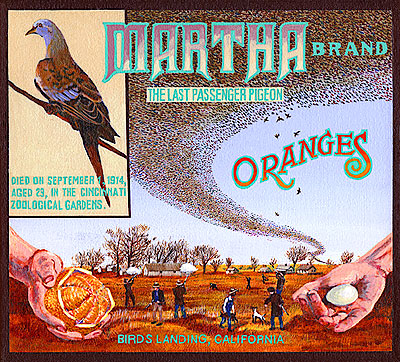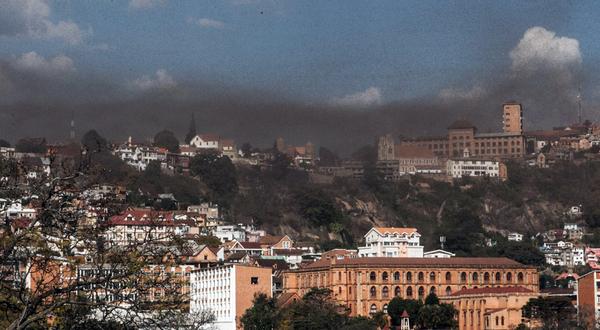
Posted on 08/31/2014 8:50:42 PM PDT by chessplayer
Tomorrow marks exactly 100 years since the last passenger pigeon, a female named Martha, died in captivity at the Cincinnati Zoo.
At their peak, millions — some argue billions — of passenger pigeons flew together, creating such a ruckus as to make normal conversation a challenge. Yet their numbers diminished rapidly, plunging perilously close to extinction within just a few decades thanks to our voracious appetite for the birds. Then they flamed out completely, the last wild one shot in 1900 and Martha dying 14 years later. “The bird was hunted out of existence,” wrote journalist Barry Yeoman in Audubon magazine, “victimized by the fallacy that no amount of exploitation could endanger a creature so abundant.”
That the species went extinct still shocks the system. Consider their abundance.
We need to imagine Martha asking us, ‘Have you learned anything from my passing?’”
(Excerpt) Read more at weather.com ...
If the passenger pigeon was still around Monsanto would be developing a pigeon resistant GMO crop.

Although humanity may have played a large role in the demise of this species, there are many other factors at play. Honey bees took over the parakeets’ nesting sites and the Carolina parakeet’s altruistic behavior of congregating around a hurt member of their flock, which ultimately would present the predator—be it human or animal—with the opportunity to kill many more than just one bird. However, it is hypothesized that, ultimately, poultry disease was the cause of the Carolina parakeet’s final extinction.http://vtwildlifebiology.blogspot.com/p/carolina-parakeet.html
And the world has not been the same since/s
That would explain their sudden extinction.
American Chestnut trees once made up about 25% of the hardwoods from Pennsylvania down to northern Mississippi and Alabama. Mature Chestnut trees were huge - they dwarfed giant oaks - and I've seen figures suggesting they made up as much as 20% of the biomass in their habitat.
Unfortunately, American Chestnut trees are not immune to the chestnut blight, while Japanese and Chinese chestnut trees are.
Around 1904, asiatic chestnut trees were introduced to the New York Botanical Garden, along with the chestnut blight. The blight began killing 50 miles of American chestnut trees a year. We lost around three billion American Chestnut trees to the blight.
There are a few locations where American Chestnut trees still grow, either because the trees had a natural resistance to the bight or were protected from the blight. Other American Chestnuts are being introduced, grafted onto Asiatic roots. New American Chestnut trees continue to sprout from the roots of dead trees, but they die from the blight by the time they hit a height of six feet.
How did I learn about these trees?
I went backpacking in the Mountain Bridge Wilderness Area in South Carolina. Within it, there's an American Chestnut tree graveyard. Although most AC trees were logged (they're huge and not susceptible to rot), this grove was protected on two sides by rock cliffs.
Ninety years after the trees died, the ground is littered with half-rotted giant trunks.
I was backpacking with an arborist, who told me about the trees. He just sat on one trunk with his head in his hands.
One of the interesting things of those areas is that in a large part it was all clear cut at some point. People often think these trees have been there forever. Not the case. It does show the resilience of nature and the ability to come back and the ability of humans to manage property.
The extinction of the the dinosaurs ultimately led to the emergence of man.
They annoyed s cat!
There is an example of a 40ft chestnut tree growing near Bat Cave NC that although stunted has some natural resistance to the blight.
North American farmers certainly don't miss the Rocky Mountain locust which went extinct in the late 1800s. Hard to see how our bread basket could have developed with those critters around. One swarm was estimated to cover 200,000 square miles and was comprised of 12.5 trillion individuals. No one knows for sure why it went extinct - they just disappeared.
Actually if you look into the history of hunting and conservation movement in the United States most of the species you mention nearly were hunted to extinction. The only one that I know for sure wasn’t was the “regular” (European) pigeon, as it had adapted to living in cities by the time it was brought over to the Americas. Even when I was a kid back in the ‘80s I can remember turkeys being nearly extinct. It had to be reintroduced to many of the places it lives now.
The reason that passenger pigeons were so easily hunted to extinction is that they were hunted by large commercial operations, at night when they all roosted closely together with punt guns (these were giant shotguns, named after the type of boat to which they were usually mounted when employed in waterfowl hunting.). These guns have been known to take out a hundred ducks in a single shot (though 50 was apparently a much more common number). Imagine what a team of hunters employing dozens of guns like that could do to a huge mass of densely packed, sleeping birds. Diseases and deforestation probably also contributed to their demise, but the odds are almost they would be around today (if not abundant) if they weren’t hunted the way they were.
Absolutely mind boggling how so many so-called Christians take great delight in the destruction of God’s Creation.
...yes, it is, isn’t it...?
...now watch, we’ll both be called vile names for having expressed a smidgeon of concern...
Imagine 25% of the trees from Pennsylvania to the lower Appalachians as Chestnut trees:

The things were enormous.

I called my arborist Scouting friend about the biomass figure; he said I'm wrong. According to him, some estimates are that around 1900, 40% of the biomass in the American Chestnut tree's growing area was American Chestnut.
Just look at the stumps of the American Chestnut trees - after 90 years of rotting - that are trying to produce new trees from the roots.

And folks living in realville (where I live) would argue that nature took its course since no species can survive overpopulation in those numbers.
Back in 1900 there were no scientific means to accurately study the sudden decline of any bird or animal and thus the typical liberal explanation is that "they were hunted to extinction".
Of course such explanation failed to mention the sparse population of humans scattered across this continent. Such sparseness could in no way impact on a population of birds in those numbers............
With that being said, it's most likely they were wiped out by a bird virus similar to the West Nile Virus which swept thru Michigan a number of years ago, killing crows and other birds such as a blue jay I found dead in my bird bath during those days.
But then again, it's much easier to blame mankind than nature itself.......
The CP became near extinct during the 19th century, otherwise known as the 1800's.......and what was the population along the east coast during those years and why didn't the bird expand westward since there was plenty of habitat for it to thrive in?
Once again, I offer that there is no substantive evidence that that bird was ever a native of this country but rather an import from South America that managed briefly to thrive on this continent until it finally died off..........not because it was shot off.
The last sighting was in 1910, and was declared extinct in 1938.
and why didn't the bird expand westward since there was plenty of habitat for it to thrive in?
It was found from southern New York and Wisconsin to Kentucky, Tennessee and the Gulf of Mexico, from the Atlantic seaboard to as far west as eastern Colorado.
‘the last of a species once the most plentiful on the planet.”
Now if we can just do it for the illegals crossing our southern border...

Disclaimer: Opinions posted on Free Republic are those of the individual posters and do not necessarily represent the opinion of Free Republic or its management. All materials posted herein are protected by copyright law and the exemption for fair use of copyrighted works.